Heating devices: how to choose a suitable device for heating
Whatever the design of the climate system you prefer for heating your own home, you will need heating appliances for the house. Their choice depends on the presence or absence of coolant, the fuel used, the area of the house and many other factors.
A significant influence on the decision to purchase has the price, power, appearance of the device. Do not get lost in all the variety of existing models and make the right choice you will help the instruction below.
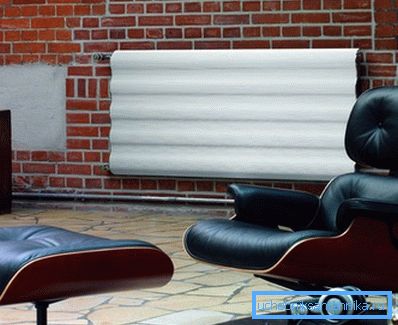
Varieties of climate devices
To better understand the variety of devices that exist on the market of climatic equipment, consider the main types of heaters, arranging them into groups depending on those or other classification criteria.
The method of heat energy exchange
First of all, the heater should be selected on the basis of the way in which it heats the room.
There are three:
- By radiation. In this case, heated in one way or another, the heating device emits infrared rays into the room, which transmit energy not to the air in the room, but to the objects in it. The latter, after warming up, also begin to radiate heat, transferring it further. This is how the whole room is heated. In most cases, the formation of local zones of heated and cold air is excluded, which has a positive effect on comfort.
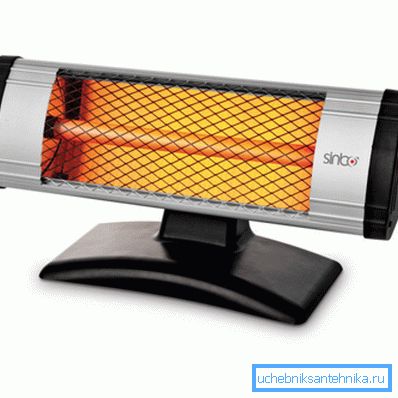
Medical research shows that radiant heating has a positive effect on human health and does not in any way harm the body.
The devices that heat a room with the help of radiation can be attributed to their varieties, which, using the described method, give more than half of the heat generated in them.
These include:
- infrared emitters;
- floor heating systems;
- some types of radiators (depending on the shape of the heat exchanger and the material);
- wall heating panels.
- By convection. It is not the objects that heat up here, but the air that comes into contact with the heat exchanger of the heating device. After warming up part of the air masses, becoming lighter, rises to the ceiling, giving way to cold air. This is how convection (mixing) of cold and warm layers in the room is organized. As a result of the heating convector, a situation arises when a person feels warmer air at the level of the chest and head, and feels discomfort near the floor where the legs are. To increase the intensity of convection in these devices are sometimes installed fans.

Convection-based heaters include models that transmit 75% of heat in this way.
In particular:
- tubular and lamellar convectors;
- steel heating radiators;
- ribbed tubes (with installed heat transfer plates).
- Combined. In this case, the devices heat the room in two ways: using convection, up to 60% of the heat is transferred, the rest is due to infrared radiation. These include:
- aluminum and bimetal radiators;
- smooth pipes;
- floor heating panels.

Manufacturing material
Another important criterion is the material from which the device is made. The main varieties are listed in the table.
| View | Description |
| Metallic | These include heating equipment made of carbon steel, cast iron, copper, aluminum, and their combinations. In particular, bimetallic radiators, which are a steel frame with an aluminum heat exchanger mounted on it, have proven to be excellent. It combines the strength of steel and high heat transfer of non-ferrous metal. |
| Non-metallic | Such heating devices are very rare in the market of climate control equipment. An example is glass, which possesses the necessary physical properties to receive and release thermal energy. |
| Combined | These include heating panels (composed of a concrete or ceramic insulation layer and an internal metal frame), as well as convectors, in which pipes, fins and casing can be made of various materials. |
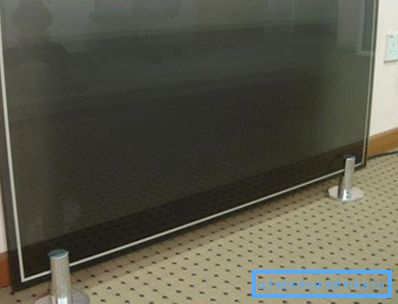
Space heating speed
Here it is necessary to take into account the degree of the so-called thermal inertia, that is, the time during which the room will be warmed after the device or the heating network is put into operation.
She may be:
- High.
- Low.
This indicator is directly dependent on the material and size of the heater.

Source of heat
The classification of heating appliances by this criterion is most common and important for heating technicians and home craftsmen who design the climate network with their own hands. The remaining configuration of the engineering system depends on the choice of a particular variety: the installation of a heating boiler, the need to install pipelines or electrical outlets, and so on.
By the above criteria are distinguished:
- Heating devices that use heat-transfer fluid as a source of heat energy. This refers to a heating device - used in central heating systems and autonomous climate networks of private houses - which is connected to the water supply pipes. Heating of the coolant occurs not in the heating device itself, but in the boiler, which is part of the network.
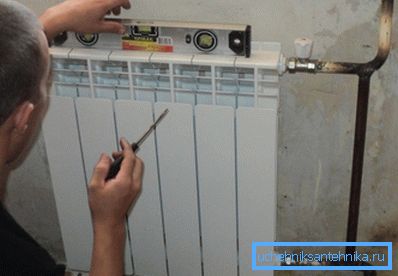
These units include well-known radiators of heating (regardless of the material, size and shape of the heat exchanger).
- Heating devices that do not use water as a source of heat. As an example, electric heating devices. Although they have a high heat transfer coefficient, the cost of operating such equipment is much higher, so they are more often used for dacha, where permanent residence of people is not expected.
Note! The difference between the two varieties listed above is also in how the heaters are mounted. In the first case, you need to start a large-scale construction work, in the second - just put the heater in the place you like (even in the middle of the room) and plug the plug into the outlet.
Another advantage of electric heating devices is the high nominal heat flux density. According to this indicator, they significantly exceed the heating radiators, which are part of the water heating system.

However, preference in private homes and apartments, where people live permanently, should be given all the same water batteries. The climate system of which they are part will be more economical, durable and easy to operate.
To facilitate your choice of heaters, let's look at some of the most popular varieties in more detail.
Types of radiators
Cast iron
This type of heating radiators was widely distributed earlier, however, and now it does not lose its popularity. The main advantage of cast-iron heating equipment is undemanding to the quality of the coolant supplied.
Cast iron batteries are well tolerated by corrosion, so the chemical and physical composition of water that flows through pipes and batteries does not need to be given special attention. Even small abrasive particles will not cause substantial damage to the solid material, and when the coolant is drained (which often happens in summer), their inner surface will not rapidly become rusty.

All of the above positive qualities make them an excellent choice for installation in apartments connected to centralized heating networks.
As for autonomous heating systems, here it is better to prefer other models, since the use of cast iron has a considerable number of disadvantages:
- Significant weight. Batteries are difficult to mount in place, for fixing them need powerful brackets. In addition, these devices exert significant loads on the structural elements of the building.
- Unattractive appearance. Cast iron batteries do not differ in design delights (with the exception of some expensive models produced by the method of artistic casting), because they do not fit well into the interior of the premises.
- Great inertia. For warming up the premises after turning on the coolant supply, a sufficiently long period of time is required.
Note! The above-mentioned disadvantage can be considered from the positive side. So, in case of emergency termination of the hot water supply to the cast iron pipes, the room will still warm for a long time, transferring to it the previously accumulated heat.
Steel
Heating devices of this type are made from steel sheets or steel pipes welded together. The first option is most common, as it has excellent consumer properties and a fairly low cost.
Structurally, the radiator consists of two steel sheets, welded to each other, in which the method of stamping made the grooves for the flow of coolant. Sometimes, in order to improve heat transfer, a metal heat exchanger is welded to the sheet.
There are single, double and triple devices, differing in different thickness and, as a consequence, power.
Despite some drawbacks - the inability to withstand strong pressure, susceptibility to corrosion and high sensitivity to the composition of the coolant - these devices are very widely used to design autonomous climate systems with a closed circle of hot water circulation.
Steel radiators from leading European manufacturers (Delongi, Kermi, Corado) and Russian models (Prado and so on) are on sale.
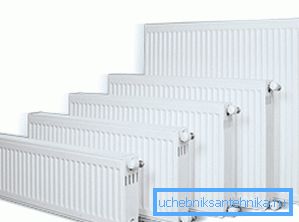
Among the professionals are highly appreciated heaters made of steel, which produces Togliatti plant appliances heating.
These devices have many advantages:
- low cost - the batteries have the best combination of price and quality;
- a small step of the nomenclature series - you can choose a model that is ideally suited to you in size and power;
- high nominal heat flow - radiators perfectly heat the room with a minimum area of devices.
Note! All batteries manufactured by the Russian plant undergo technological tests, an act of uniform heating and other necessary documents are drawn up. You can be sure that these radiators will be a reliable element of your climate network.
Aluminum
This type of heating radiators is often used to design autonomous heating systems. Consumers loved such devices for their attractive appearance and high degree of heat transfer.
The positive qualities of aluminum devices are obvious:
- attractive design;
- high power;
- a beautiful external coating that protects against adverse external influences;
- high strength.
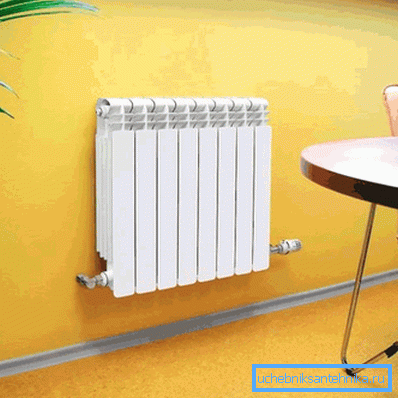
However, aluminum is very susceptible to corrosion, so even the slightest fluctuations in the acid or alkaline composition of the coolant flowing through it can lead to the destruction of the heating radiator.
Bimetallic
Structurally, such heating devices, as already mentioned, consist of metal pipes through which coolant flows, and an aluminum radiator that improves heat transfer.
These devices, which transmit heat through convection, as well as through thermal radiation, have all the advantages of aluminum models, but at the same time are deprived of most of their drawbacks.
In particular, due to the design features, the contact of the coolant with aluminum is completely excluded, therefore, the formation of corrosion can be ignored. In addition, steel is much stronger than non-ferrous metal, because the battery is not afraid of hydraulic and pneumatic impactors that occur in centralized heating networks.
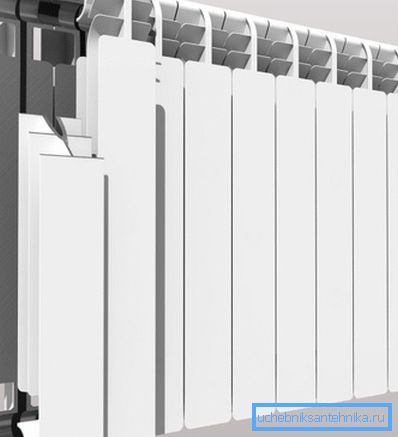
The only downside is the high cost. The price of bimetallic radiators is one of the highest among similar products.
Types of electrical heating devices
Due to the fact that electrical appliances can not be attributed to cost-effective ways to maintain a comfortable microclimate in winter, they are less common and are used to solve specific problems.
Nevertheless, we briefly list their main varieties:
- Electric convectors. Externally, they resemble classic water radiators, but do not require a heat transfer fluid to operate. It is enough to connect the device to the outlet and enjoy the heat.

- Infrared heaters. They are related to equipment that heat a room with radiant energy. They quickly heat the room, but consume a large amount of electricity, therefore they are one of the least economical. Often used as a backup heat source.
- Electric floor heating. Special heaters laid under the floor covering. The principle of their operation does not differ from a water heated floor, except for the order of installation and the energy carrier used.
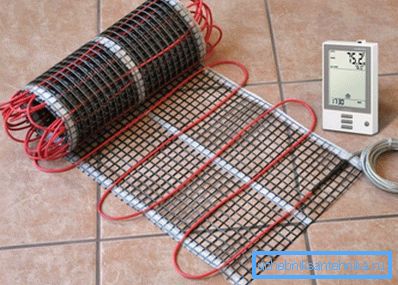
- Fan heaters. The air passing through its body is quickly heated, but during operation they make a lot of noise.
Conclusion
The above information will certainly provide you with invaluable assistance in choosing the right climate equipment. However, convectors and radiant heaters that require liquefied bottled gas for operation were not considered here. For more information about them, see the video below.